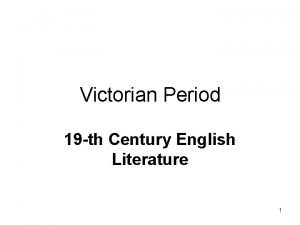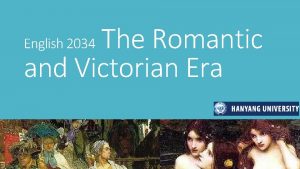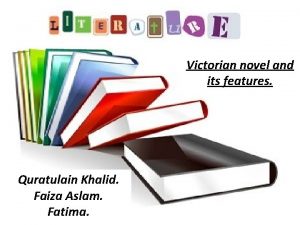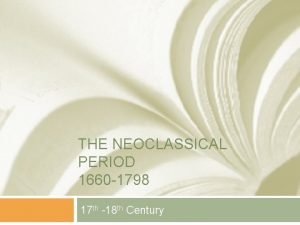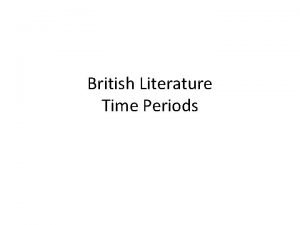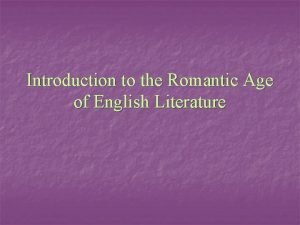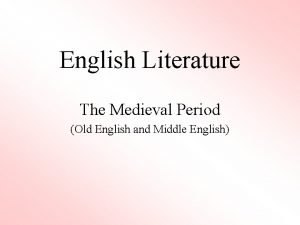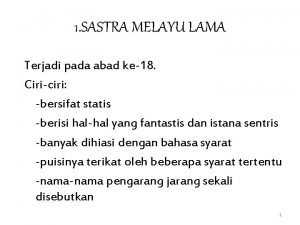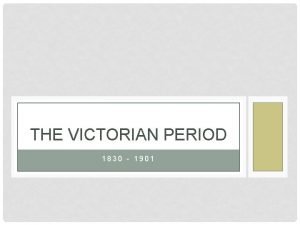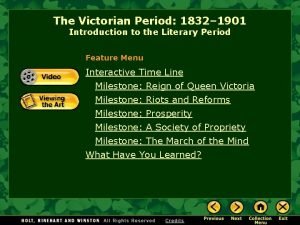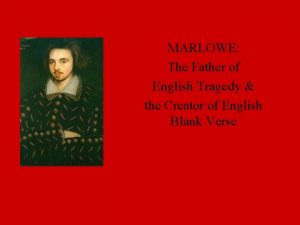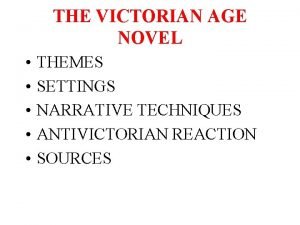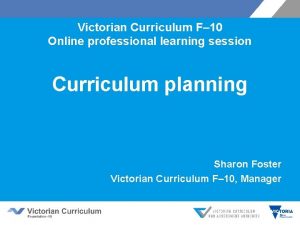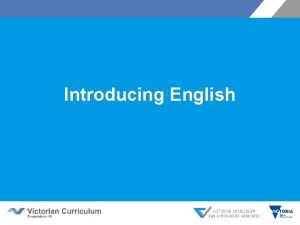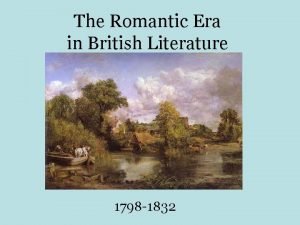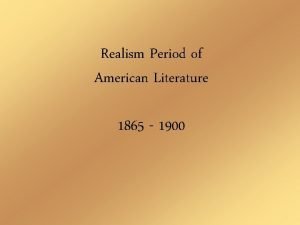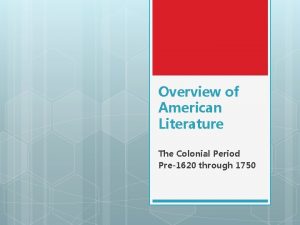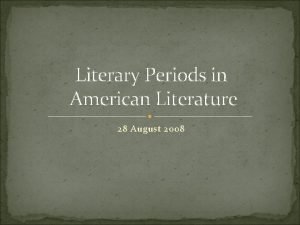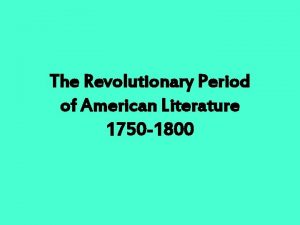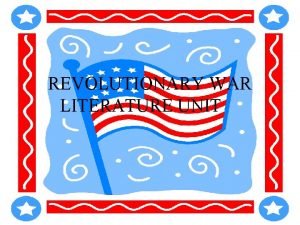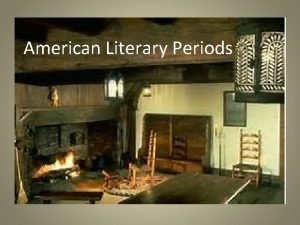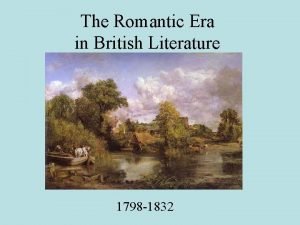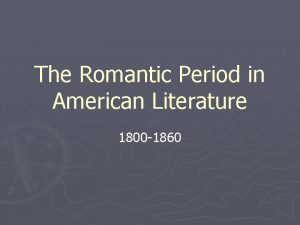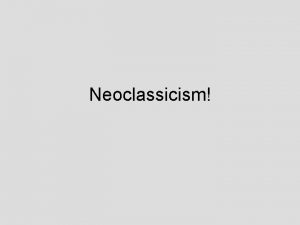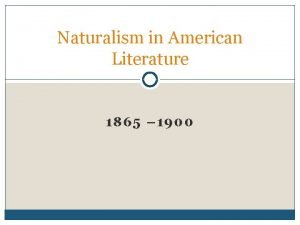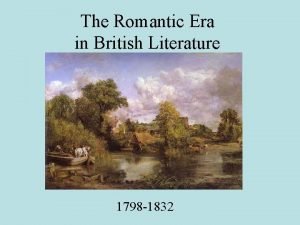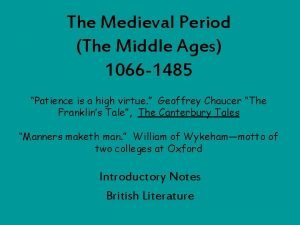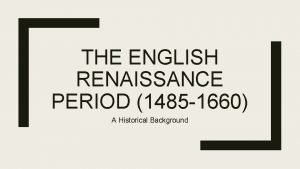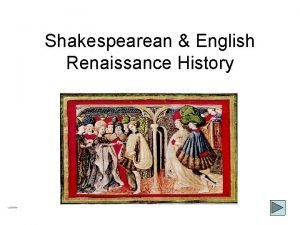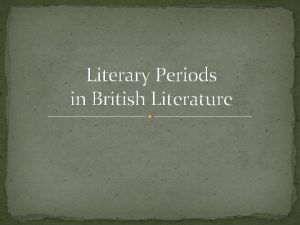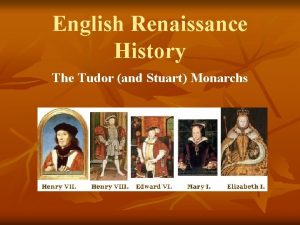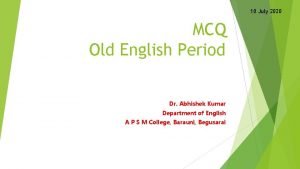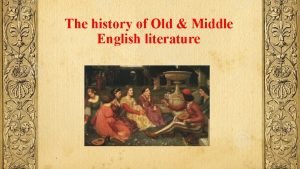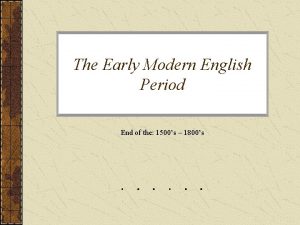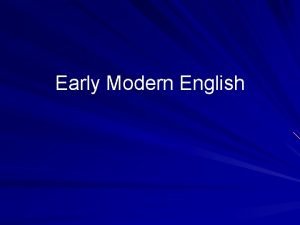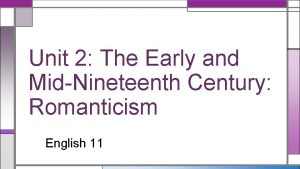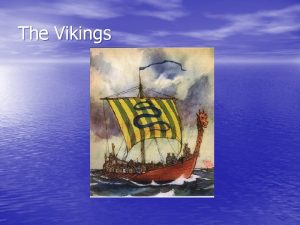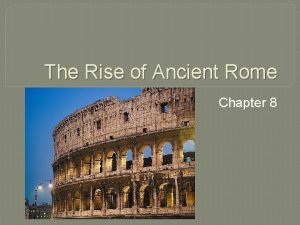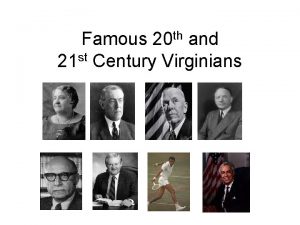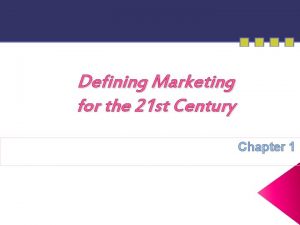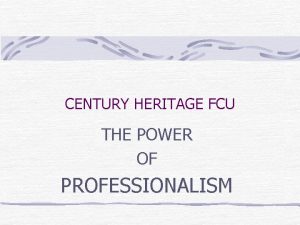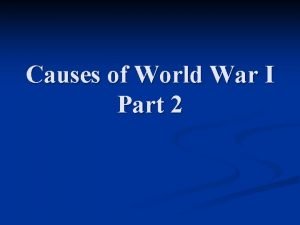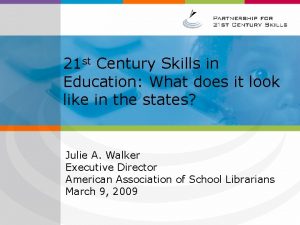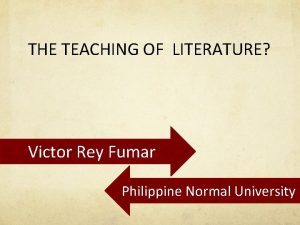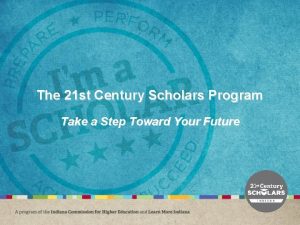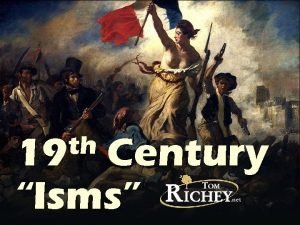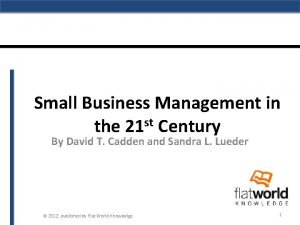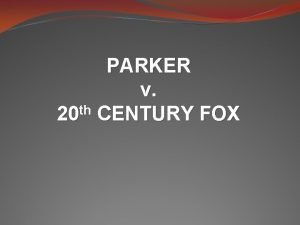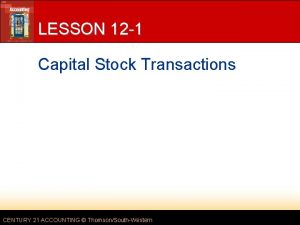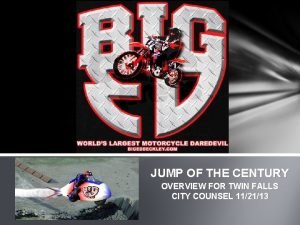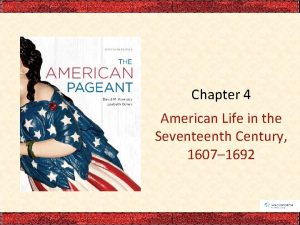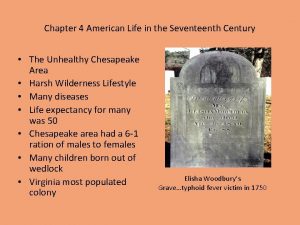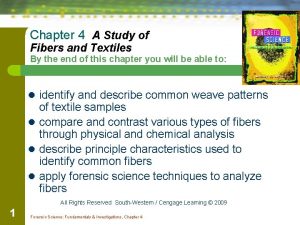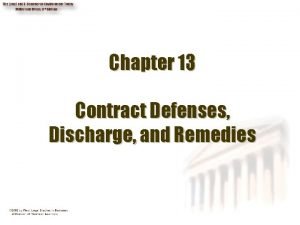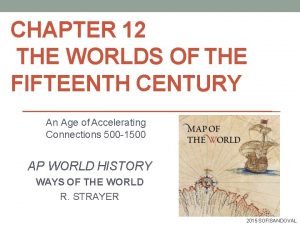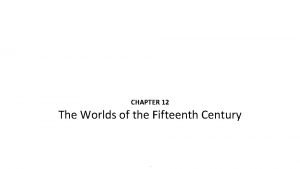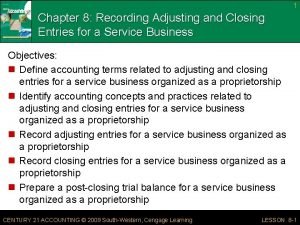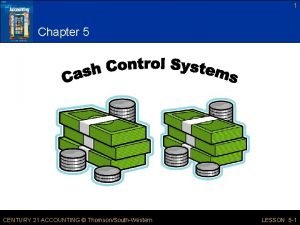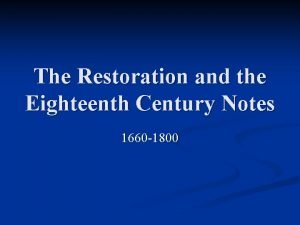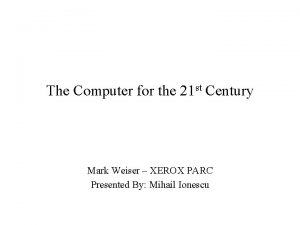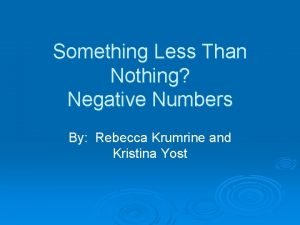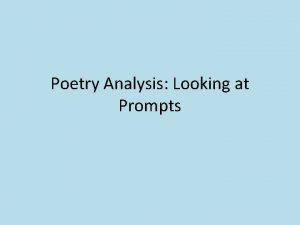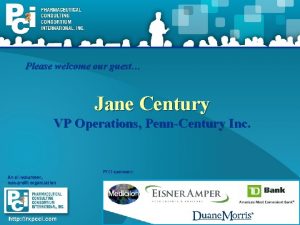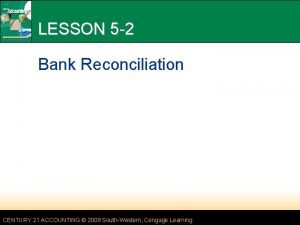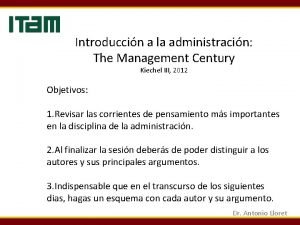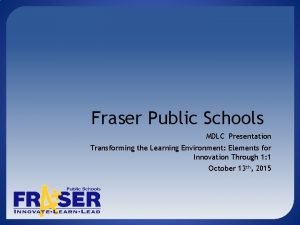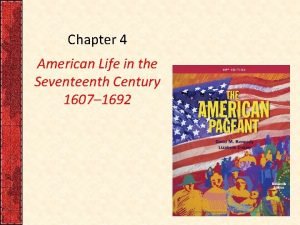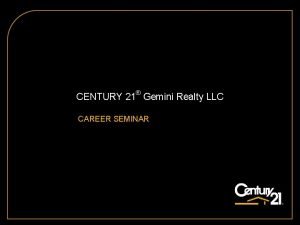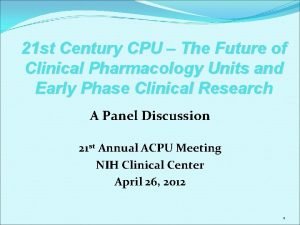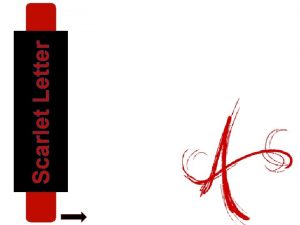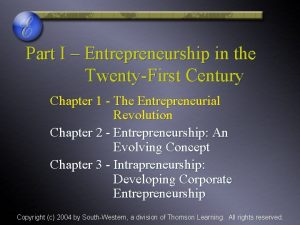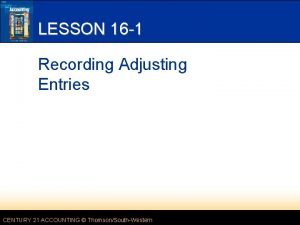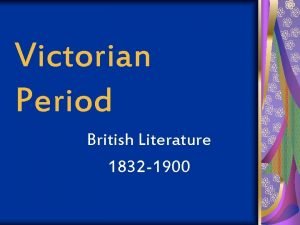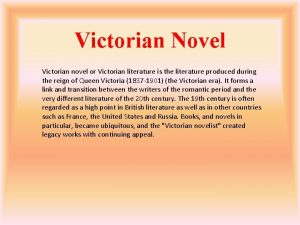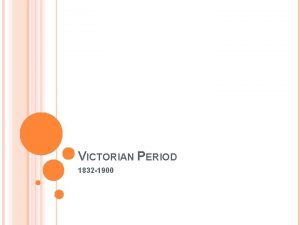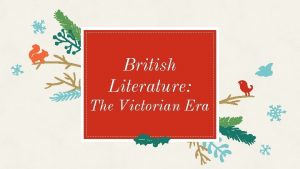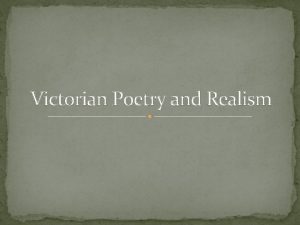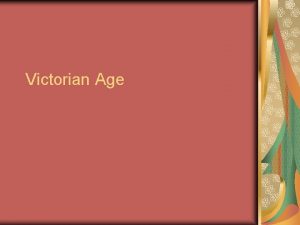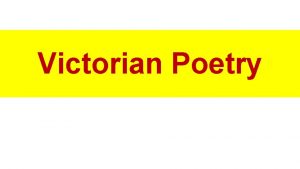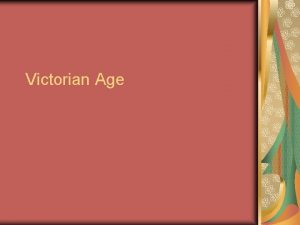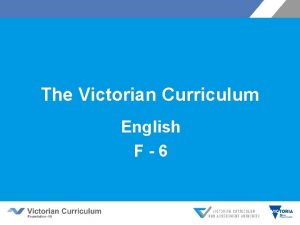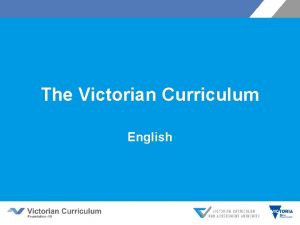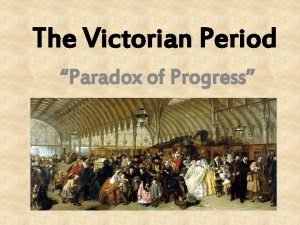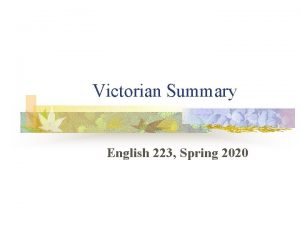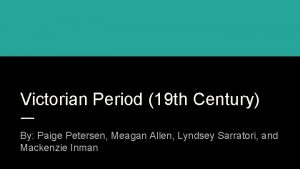Victorian Period 19 th Century English Literature 1


































































































- Slides: 98

Victorian Period 19 -th Century English Literature 1

Victorian Age: Mood of: ENERGY SUCCESS • INDUSTRIAL REVOLUTION (STEAM ENGINE 1775); • CHANGES IN TRANSPORTATION (import, export of large goods, connection btw. towns) • OPPORTUNITIES (OPENING NEW COLONIES);

POSITIVES -NEGATIVES • CHANGES IN PHILOSOPHICAL THOUGHT (Jeremy Bentham: Greatest happiness for the greatest no. of people; Thomas Robert Malthouse: population law; “Young England“ organization: Thomas Carlyle, Benjamin Disraeli); • CHANGES IN ECONOMIC THOUGHT (laissez faire doctrine); • CHANGES IN RELIGIOUS THOUGHT (Age of Religion vs. Positivism vs. Spencerian Evolutionism: Always towards Perfection).

LITERARY INFLUENCES (1): • “Age of journals”: Qarterly (1809); Household Words, Cornhill Made possible by 2 facts: 1. Educated reader (Education Act); 2. Availability of press (Taxes reduced).

LITERARY INFLUENCES (2): • “Age of photography” (clarity, precision) • Ch. Dickens: OT: An unfinished coffin on black tressels, which stood in the middle of the shop, looked so gloomy and death-like that the cold tremble came over him, every time his eyes wandered in the direction of the dismal object, from which he almost expected to see some frightful form slowly rear its head, to drive him mad with terror. Against the wall were ranged, in regular aray, a long row of elm boards cut into the same shape. . . Coffin plates, elm-chips, bright-headed nails and shreds of black cloth, lay scattered on the floor. . . (75) (good observer, authentic, sensational, gothicnovel atmospehre) • V. Woolf (criticises): . . . they have become two of the most conspicuous figures in that bright and animated company of authors, who thanks to our modern habit of writing memoirs and printing letters and sitting to be photographed, live in the flesh, not merely as of old in the world; are known by their hats, not merely by their poems. What damage the art of photography has inflicted upon the art of literature has yet to be reckoned. (A. Leigh in Common Reader).

LITERARY INFLUENCES (3): • Literary paragons: • Germany: Arthur Shopenhauer (17881860): “Die Welt als Wille und Vorstellung” – resignation to will; • USA: Thomas Paine: Common Sense Mark Twain (1835 -1910), J. London (1876 -1916)

Periods of Victorian Literature • Predecessors/Antecendents: Romanticism (1776 -1830) 1. EARLY VICTORIANS (1830 -1880); 2. LATE VICTORIANS (1880 -1930) – fin de siècle. • • Early Victorian Novel (1830 -1880): Ch. Dickens, W. M. Thackeray, Ch. , E. , A. Bronte, G. Eliot, E. Gaskell Early Victorian Poetry (1830 -1880): A. Tennyson, R. Browning, M. Arnold, A. H. Clough Late Victorian Novel (1880 -1930): A. Ch. Swinburne, O. Wilde, T. Hardy, H. James Late Victorian Poetry/Drama (1880 -1930): O. Wilde Modernist poetry: R. Brooke, W. B. Yeats Modernist Novel: D. H. Lawrence, V. Woolf, J. Galsworthy, A. Bennett, H. G. Wells, E. M. Forster, J. Conrad, James Joyce, K. Mansfield, Evelyn Waugh Literature between two World Wars (Modern British Literature)

Genres and styles of Victorian literature • GENRES: social novel • STYLE: critical realism

The Victorian Social Novel Benjamin Disraeli (1804 -1881) • the novel –an excellent means of persuation and for conveying political ideas. • Trilogy: Coningsby (1844), Sybil (1845) and Tancred (1847) • The first real political novels in history 9

Charles Dickens (1812 -1870) CRITICISM: Churchill, R. C. : The Genius of Charles Dickens: (117 -137). In: The New Pelican Guide to English Literature, Part 6. ISBN 0 -14 -013812 -9 (please read before exam) BIOGRAPHY: Wrote of competence: • B. in London (A Christmas Carol); • Father indebted (The Pickwick Club); • Attended boarding school (Oliver Twist); • Worked as a scrivener (A Christmas Carol); • Fell in love with a better-off, better-class maid ( ); • Spent some time in France (A Tale of Two Cities); • Travelled to America (American Notes, Martin Chuzlewit); • Exposed to public scandal: divorced his wife for an actress NOVELS: Most romantic: A Tale of 2 Cities Most American: American Notes (1842), Matin Chuzzlewit (slavery vs. Land of Freedom) Most popular and autobiographic: David Copperfield The gloomiest: Bleak House Most psychological (psychological realism): Little Dorrit D´s PHILOSOPHICAL PLATFORM: Philantropy and charity are the means to reform.

Periods of Dickens´ Artistry 1. Early Years (pseudonym Boz, Timothy Sparks, published in Monthly Magazine 1833); 2. Master Years 3. Late Years - Extremely productive author: Pickwick and OT run side by side

1. Early Years (pseudonym Boz) 1. The Pickwick Papers – inspired by M. de Cervantes (eccentric master Pickwick and his servant Sam Weller) - symbol of Reason vs. Romantic idealism; - Merry vs. Realistic England; - Humor leading to satire:

1. Early Years (pseudonym Boz); 2. Oliver Twist - From misery to good fortune; - OT – undertaker´s apprentice escapes to London - CONTRIBUTION: de-idealises world of criminals as portrayed by Gay, Lytton.

1. Early Years (pseudonym Boz); 3. Life and Advetures of Nicholas Nickleby - Young teacher revenges his mean principal - CONTRIBUTION: de-idealises English boarding schools.

2. Master Years 1. Dombey and Son - Dombey = the owner of marine transportation 2. David Copperfield - Created many archetypes: - -greed: Uriah Heep - -limitless optimism: Mr. Micawber

3. Late Years 1. Bleak House – most psychological, Kafka-esque 2. Hard Times – the shortes, simplest novel 3. Little Dorrit – coined “Circumlocution Office“ 4. A Tale of Two Cities – London/Paris, inspired by the French Revolution 5. Great Expectations – Pip = Phillip Pirrip 6. Our Mutual Friend, The Mystery of Edward Drood (unfinished).

DICKENS´ CONTRIBUTION 1. DICKENS´ ENGLAND 2. DICKEN´S LANGUAGE, HUMOR, IRONY: Upon this, the parish authorities magnanimously and humanely resolved, that Oliver should be ´farmed´, or, in other words, that he should be dispatched to a branch-workhouse some three miles off, where the twenty or thirty other juvenile offenders against the poor laws rolled about the floor all day without the inconvenience of too much food or too much clothing. . . OT, 48/4 3. DICKENS´SOCIAL CRITICISM: “So they established the rule, that all poor people shoud have the alternative (for they would compel nobody, not they), of being starved by gradual process in the house, or by a quick one out of it“ OT, 55/. 4. DICKENS´SOCIAL CRITICISM: “Why, it´s what I´m obliged to keep a little in the house, to put the blessed infants´Daffy when they ain´t well, Mr. Bumble, replied Mrs Mann as she opened a corner cupboard, and took down a bottle and glass. It´s gin. I´ll not deceive you, Mr. B. It´s gin. “ ´Do you give the children Daffy, Mrs. Mann? ´. . . ´Ah, bless ´em, that I do, dear as it is, replied the nurse. I couldn´t see ´em suffer before my very eyes, you know sir´. (OT, 51).


VICTORIAN WOMEN WRITERS • Man for the field and woman for the hearth: • Man for the sword and for the needle she: • Man with the head and woman with the heart: • Man to command woman to obey. • ( A. Tennyson: The Princess) 19

• 1850´s – campaigns for employment opportunities for women • The problem – surplus or redundant women (imbalance in numbers between the sexes) • Bad working condition and unemployment - prostitution • Governess – the only occupation at which an unmarried middle-class woman could earn living • The governess novel 20

Victorian Women Writers • The Bronte Sisters • Charlotte (1816 -55) Emily 1818 -48), Anne (1820 – 4) • Secluded life in Yorkshire • Innfluenced by Byron and Scott • Angria and Gondal – imaginary worlds • Currer, Ellis and Acton Bell – pen-names 21

• novels set against the background of the beautiful and wild moors of their home in Yorkshire. • contents focused on injustices and social problems. • Ch´Shirley (1849) – the background of the Luddite riots, it illustrates the need to give women more useful occupations. • Ch´s Jane Eyre (1847) portrays Jane as a woman who has decided she has the power to act and decide for herself. 22


Emily Bronte Gothic features: • Setting, tone • Characters (Joseph = Puritan) • Motifs, symbols: evil = nature or nurture?

George Eliot (Mary Ann Evans (1819 – 1880) • • • Strict religious schooling A radical, an intellectual Influenced by Darwin and by German philosophy Became a Methodist when she was young Soon lost her Christian beliefs, choosing instead to see life as fully determined by one´s own choices and actions • 1851 -59 became assistant editor of the Westminster Review 25

• - wrote three realistic sketches which appeared in Blackwood´s Magazine under the pen-name chosen for her by H. Lewes. The sketches were published the following year as Scenes of Clerical Life. • Eliot translated David F. Strauss´s Life of Jesus. • L. Feuerbach´s Essence of Christianity ( an indication of the change that was taking place in her thinking. ) • George Eliot´s concern is moral, psychological and philosophical. 26

• Her aim is to portray everyday people´s problems with life, their conflicts of conscience between duty and desire, and their tragedies. • Eliot´s novels: • Adam Bede (1859) • The Mill on the Floss (1860) • Silas Marner (1861) • Middlemarch (1871) 27



Victorian Poets • • A. Tennyson, the Brownings, M. Arnold still esentially Romantic character Victorian in the sense that they expressed: Doubts and conflicts regarding the Victorian society, with the emphasis on science, progress and materialism at the expense of faith and spiritual sentiment. 30

Alfred, Lord Tennyson (1809 – 1892) • Early poems in the style of those of Keats, which delighted in the senses. • later poetry published in two volumes, became very successful • In The Princess, A Medley (1847) enlarged and revised in 1850, he treats theme of equality of the sexes. . The first three books of poetry (1833, 1832, 1842) include Tennyson´s best work e. g. Mariana, The Lady of Shalott, Ulysses, Morte d´Arthur, The Lotos-Eaters. • Later, new developments in scientific progress led him to contemplate on the changing world. For Tennyson, doubt was the basis of his inspiration. • In, In Memoriam A. H. H. – a series of elegies (1833 -1850), - comments on change and evolution and contemplates the question of man’s destiny and immortality in the age of new discoveries. Queen Victoria declared that she valued it next to the Bible. • 31

• Despite Tennyson’s Romantic spirit, he was a Victorian who shared the fundamental ethos of the Victorian age. • Ulysses(1833), illustrates the Victorian morality of self-control and self-discipline as a means to continue and succeeed. • The Idylls of the King (1859 -72) his popular series of poems on episodes from the legends of King Arthur. • Tennyson - in constant protest against the individualism, which the Victorian era inherited from the Romantic period. • Appointed Poet Laureate in 1850. 32

• Despite Tennyson’s Romantic spirit, he was a Victorian who shared the fundamental ethos of the Victorian age. • Ulysses(1833), illustrates the Victorian morality of self-control and self-discipline as a means to continue and succeeed. • The Idylls of the King (1859 -72) his popular series of poems on episodes from the legends of King Arthur. • Tennyson - in constant protest against the individualism, which the Victorian era inherited from the Romantic period. • Appointed Poet Laureate in 1850. 33

Robert Browning (1812 – 1889) • Aware that he was writing poetry in an age of science, of technology and prose. • Interested in the study of human soul. • From the very start he discussed in monologue, problems of life and conscience. • His poem, Pauline was a fragment of personal confession. • In Paracelsus (1835) he described the strange career of the Renaissance physician, in whom true science and charlatanism were combined. • B‘s main literary inspiration - P. B. Shelley. • His early long poem Sordello (1840) poem - the relationship between life and art - recognized as one of his most extraordinary and important works. • Browning’s admiration for the’ subjective poet´ soon gave way to a desire for greater objectivity which led him to his ‘dramatic monologues ‘ • The dramatic monologue - Browning’s main achievement. 34

• B’s mature poetry, portrays exciting controversial characters, some based on historical figures, some products of his imagination: • Dramatic Romances and Lyrics ( 1845 ) , Men and Women (1855 ), Dramatis Personae ( 1864). • Browning’s most ambitious work, the long narrative of a 17 th-century murder story is The Ring and the Book (1868 - 69). • The poem consists of 10 verse narratives, all dealing with the same crime, each from a different viewpoint. • Based on an actual trial, the record of which Browning discovered in Florence. • Browning´s fame rests on the volumes, published between 1842 and 1864, which contain his love poems and dramatic monologues. 35

Elizabeth Barett-Browning (1806 – 1861) • Began writing in old-fashioned form • Influences: the Bible, the Greeks, Byron and Shelley. • An imitation of Coleridge in her impressions of the Middle Ages • Wrote many of her short poems for magazines, • the most important contribution The Cry of the Children (1844), a protest against the employment of children in factories. • In 1845, Robert Browning met her, fell in love with her, and persuaded her to elope with him to Italy. 36

• In a series of forty-four sonnets she recorded her growing love for Browning and her fears and doubts about her ill health and unworthiness of such love. • After their marriage trip to Italy, she finally showed the sonnets to her husband he insisted that they be published. • Because the sonnets were deeply personal, she decided to present them as translations, calling them Sonnets from the Portuguese. They were published in 1850 in the volume Poems. • B. - a passionate supporter of Italian independence - in her work by Casa Guidi Windows (1851) • Aurora Leigh (1857) deals with themes of social responsibility and the position of women. • 37

Matthew Arnold (1822 -88) • Poet, critic and educationalist • - received a fine classical education at Oxford. • wrote a series of essays on literary and social topics (while at the same time earning his living as an inspector of schools). • constantly looked to the classics for symbols of permanence and stability. • In his poem To a Friend, he named Homer, Epictetus and Sophocles as the three writers to whom he turned for mental and moral support. • Sophocles is mentioned again in Dover Beach. In that poem Arnold finds consolation in the thought that sadness of the sea was also heard by Sophocles so long time ago. • Arnold’s turning to the past and his praise of classical writers reflect his dissatisfaction with the present. The impact of the revolutions in industry and science was not comforting, and Arnold, like other Victorians sought refuge in faith. 38

• Matthew Arnold: Dover Beach • The sea is calm to-night. The tide is full, the moon lies fair Upon the straits; on the French coast the light Gleams and is gone; the cliffs of England stand; Glimmering and vast, out in the tranquil bay. Come to the window, sweet is the night-air! Only, from the long line of spray Where the sea meets the moon-blanched land, Listen! you hear the grating roar Of pebbles which the waves draw back, and fling, At their return, up the high strand, Begin, and cease, and then again begin, With tremulous cadence slow, and bring The eternal note of sadness in. • Sophocles long ago Heard it on the Agaean, and it brought Into his mind the turbid ebb and flow Of human misery; we Find also in the sound a thought, Hearing it by this distant northern sea. 39

• • The Sea of Faith Was once, too, at the full, and round earth's shore Lay like the folds of a bright girdle furled. But now I only hear Its melancholy, long, withdrawing roar, Retreating, to the breath Of the night-wind, down the vast edges drear And naked shingles of the world. Ah, love, let us be true To one another! for the world, which seems To lie before us like a land of dreams, So various, so beautiful, so new, Hath really neither joy, nor love, nor light, Nor certitude, nor peace, nor help for pain; And we are here as on a darkling plain Swept with confused alarms of struggle and flight, Where ignorant armies clash by night. 40


The Late Victorians • Scientific Discoveries and Philosophy • Charles Darwin (1809 -1882): On the Origins of Species by Means of Natural Selection (1859). The Descent of Man (1871). • Charles Lyell (1797 -1875): The Principles of Geology (1830 -33). 42

The Last Quarter of the Century • The working classes achieve better living conditions. • Decadence – cultural mood of the end of the century. • A new attention focused on „the unconscious“ (Stevenson and H. James) and pessimism (T. Hardy). • The sense of decline of the colonial system (R. Kipling and J. Conrad). • The end of the c. - marked by despair. • The only possibility of „salvation“ offered by the aesthetic vision of such authors as Pater and Wilde. 43

Rudyard Kipling (1865 -1936) • • Born in Bombay (India). 1872 – sent to Boarding school in England 1882 -89 – worked as a journalist in India. 1888 - Plain Tales from the Hills (short stories, Barrack-Room Ballads – poetry (1892), The Jungle Book (1894 -95), Recessional (1897) Kim (1901), Just So Stories (1902) 44

• Kipling exalted English imperial power as a sacred duty „the white man´s burden“ • The job of the whites and Anglo-Saxons to carry progress and civilization to the wilds. • It was a burden – it involved exile, personal sacrifice and dedication to an ideal of duty. • Kipling became the first Englishman to recieve the Nobel Prize for Literature (1907). 45

Joseph Conrad (1857 -1924) • Józef Teodor Konrad Korzeniowski -born in the Ukraine • Father, a Polish patriot imprisoned by the Russians and exiled in Northern Russia • 1874 – went to Marseilles and became an apprentice in the merchant marine • 1877 -78 period of adventure (smuggling and gambling) • 1878 -94 – worked in the British merchant marine • 1889 - started Almayer´s Folly 46

• 1890 voyage to the Congo • 1894 became a full-time writer • Novels: The Nigger of the Narcissus (1897), Heart of Darkness (novella-1899), Lord Jim, (1900), Nostromo (1904), Under Western Eyes (1910) • Conrad´s attitude to the English imperial power was more critical • For him the imperialistic ideology was a way of concealing reality based on theft, brutal aggression, uncontrolled violence and economic exploitation 47

Heart of Darkness Kurtz: Going up that river was like travelling back to the earliest beginings of the world, when the vegetation rioted on the earth and the big trees were kings. An empty stream, a great silence, an impenetrable forest. The air was warm, thick, heavy, sluggish. There was no brilliance in the sunshine. On silvery sandbanks hippos and alligators sunned themselves side by side (66). 1) STYLE: stream of consciousness: long complex sentences, minimized punctuation (and missing), cummulation of images (observations); 2) MOTIFS/SYMBOLS: water (river, stream) exotic land = demonized not idealised; symbols of danger: alligators allying with hippos; symbols of resistance = impenetrable forest, veg. rioted

Heart of Darkness • Indirect criticism of slavery:

Thomas Hardy (1840 -1928) • Born near Dorchester; his father was a stonemason. • 1856 -61 – apprenticed as an architect. Started writing poems. • 1862 -67 – worked for an ecclesiastical architect in London. • Hardy´s novels – all set in the imaginary county of Wessex (the native Dorset). 50

• Influenced by Darwin, Spencer, and Mill • Hardy believed in determinism and turned into a pessimistic philosophy of life. • „Fate controls everything, suffering is inevitable. Man is caught in the ironies of life which lead him to destruction. “ • His characters live close to nature; they have bond with the earth, the stones, the past, and exist in a sort of timelessnes • This harmony is usually destroyed by change and by man´s high aspirations 51

• • Novels: Desperate Remedies (1871) Under the Greenwood Tree (1872) Far from the Madding Crowd (1974) The Return of the Native (1878) The Mayor of Casterbridge (1886) Tess of the d´Urbervilles (1891) Jude the Obscure (its publication caused scandal and Hardy turned to poetry). • Wessex Poems (1898, The Dynasts (1903 -8) 52



A Return to the Values of Beauty and Spiritual Life • Victorian society gave rise to an unsettled feeling of doubt and pessimism about the present and the future. • Thomas Carlyle proposed the abolishion of democracy • Matthew Arnold – return to the classical world of ancients as a way of restoring a long lost harmony. • New scientific discoveries and the rational and materialistic approach to life – influenced the religious sphere. • Some members of the Anglican Church advocated a return to the ritual of the medieval tradition. • Reaction – the Anglo-Catholic Oxford Movement – John Henry Newman

Pre-Raphaelite Movement and Art • - founded in 1850 • Dante Gabriel Rossetti – painter and poet • The painters Holman Hunt, William Morris, John Everett Millais and the sculptor Thomas Woolner • - opposed the existing trend in Victorian art represented by the works of the Royal Academy and the classical doctrines by Sir Joshua Reynolds (1723 -92) • The movement rejected the classical origin of Renaissance art initiated by Raphael, in favour of the medieval tradition. • The aim of the movement – to stimulate a complete return to the simplicity of nature • Gradually assumed an aesthetc tendency of „art for art´s sake.

• John Ruskin (1819 -1900) • R. saw in the Industrial Revolution and Utilitarianism (belief that something is morally right if it helps a majority of people) the total negation of beauty (the source of all spiritual well-being) • His main concern – art and he called for a return to nature and to the values of medieval times. • Model – the Gothic style • The Seven Lamps of Architecture (1849) • The Stones of Venice (1851 -53) • His philosophy involved him in questions of social reforms – Unto This Last (1860) • R. subsidised the building of model houses for workers and their families and encouraged the founding of museums.

• Algernon Charles Swinburne (1837 -1909) • Influenced by T. Gautier and C. Baudlaire. • B. expressed the essence of life in his ´The Flowers of Evil´(1857). • Disillusionment with the world, sadness, despair, an excessive preoccupation with self, perversity, sensuousness and eroticism. • Swinburne – unconventional in political beliefs • Poems and Ballads (1860). 58



The Aesthetic Movement: Pater and Wilde • Walter Pater (1839 – 94) – the founder and theorist of the English E. Movement • Art for art´s sake was to be the motto of the EM. • Passion for the Italian Renaissance was the ideological basis for Pater´s Studies in the History of the Renaissance (1873) • Pater refuses faith or any other ethical system criticized by Oxford academics 61

Oscar Wilde (1854 -1900) • Born in Dublin. • 1871 -1879 - Trinity College, Dublin and Magdalen College, Oxford • As a disciple of W. Pater- put pleasure before morality • „ The first duty of life is to be as artificial as possible. What the second duty is no one has yet discovered. “ • W. totally adopted the aesthetic ideal and lived his life as a work of art. “comedy of manners“, farce (of tradit. high literature: hero, plot, ending). 62

• 1888 a volume of children´s fairy tales: The Happy Prince and The House of Pomegranates • The Picture of Dorian Gray (1890)- the novel considered scandalous. • Salomé (1891) written in Paris (refused production in England). • Lady Windemere´s Fan (1892). • A Woman of No Importance (1893). • An Ideal Husband The Importance of Being Earnest (1895). 63

Reflexion of the Victorian Age in OW´s fiction: The Happy Prince: 1) Indirect social criticism (poverty, homeless children): So the swallow flew over the great city, and saw the rich making merry in their beautiful houses, while the beggars were sitting at their gates. He flew into dark lanes and saw white faces of starving children (22)

Reflexion of the Victorian Age in OW´s fiction: The Happy Prince (a fairy-tale for children): 2) Outer and Inner nobility of heroes (The Prince = noble by sight (golden) but also by heart (donates his gold to poor mother, artist, etc); Swallow = donates her life to help the poor Vs. : Then they melted the statue in a furnace and the Mayor held the meeting of the Corporation to decide what was to be done with the metal. “We must have another statue, of course, he said, and it shall be the statue of myself“. „Of myself“, said each o the town councillors and they quarelled. When I las heard of them they were quarelling still (26). – greedy, selfimportant, immersed into non-problems

Reflexion of the Victorian Age in OW´s fiction: The Happy Prince: 3) Personal issues: forbidden/unusual love: One night there flew over the city a little Swallow. His friends had gone away to Egypt 6 weeks before but he had stayed behind for he was in love with the most beautiful Reed. „It is a ridiculous attachement, twittered other swallows; „She has no money, and far too many relations“ (6).

Reflexion of the Victorian Age in OW´s fiction: The Happy Prince: 4) To what end is Art? : So they pulled down the statue of the Happy Prince. “As he is no longer beautiful he is no longer useful“, said the Art Professor at the University (26). - Art doesn´t have to be useful. - Art pleases the beholder. - Pleasure is more important than profit.

Wilde´s quotations: • „I can resist everything except temptation. “ • „In this world there are only two tragedies. One is not getting what one wants, and the other is getting it. “ • „What is a cynic? A man who knows the price of everything and the value of nothing. “ • „Children begin by loving their parents. After a time they judge them. Rarely, if ever, do they forgive them. “ • „All women become like their mothers. That is their tragedy. No man does. That´s his. “ • „I am the only person in the world I should like to know thoroughly. “ 68

Wilde´s quotations: • „I can resist everything except temptation. “ • „In this world there are only two tragedies. One is not getting what one wants, and the other is getting it. “ • „What is a cynic? A man who knows the price of everything and the value of nothing. “ • „Children begin by loving their parents. After a time they judge them. Rarely, if ever, do they forgive them. “ • „All women become like their mothers. That is their tragedy. No man does. That´s his. “ • „I am the only person in the world I should like to know thoroughly. “ 69



Literature before the First World War(The Edwardian Period) • The main focus on the Victorian age – its social history and its values • Samuel Butler (1835 -1902) – The Way of All Flesh (1903) – an attack on the hypocricy of Victorian family life • John Millington Synge- (1871 -1909) – Irish playwright: Riders to the Sea (1904), The Playboy of the Western World (1907) – set in the world of the peasants on the Isle of Arran. • John Galsworthy - (1867 -1933) The Man of Property (1906), (The Forsyte Saga) – describing a typical middle-class London family of the last decades of the 19 th century. • Literature presented a total picture of English society as it moved towards the new century. • Arnold Bennett - (1867 -1931) – The Old Wives´Tale (1908). • Gilbert Keith Chesterton (1874 -1936) – The Man Who Was Thursday (1908) 72

• Greatest contribution of the Edwardian literature – its awareness of social change. • Mostly concerned with the implications of living in a new scientific world with a rapidly developing technology. • Experiments in literary form – more evident. • A split between two different kind of novelist. • The realists: A. Bennett and J. Galsworthy - the dynamism of modernity. • The modernists D. H. Lawrence, J. Joyce, V. Woolf – novel as anti-realistic art form. • G. B. Shaw and H. G. Wells – best represent the transition between Victorian and Modern. 73

George Bernard Shaw (1856 -1950) • Influenced by Henrik Ibsen. • 1884 a member of the Fabian Society – socialists - advocated progressive social reforms by democratic means (Beatrice and Sidney Webb). • Also well-known as a musical critic. • Plays Pleasant and Unpleasant (1898). • Widower´s House – S. ´first play. • Mrs Warren´s Profession, The Philanderer, Caesar and Cleopatra – a historical play. • Man and Superman, Major Barbara. • Pygmalion (1912) • 1925 – awarded the Nobel Prize for Literature. 74

Herbert George Wells (18661946) • - leader of advanced political thought of his day. • - concerned with comtemporary social problems. - worked as a chemist • - won scholarship at the Royal College of Science (studied biology). • - taught in several schools and wrote for scientific journalism. 75

• Mid-nineties turned to professional writer. • Scientific study made him a passionate believer in the perfectability of mankind through scientific advance. • Wells´s prophetic books (science fiction): • The Time Machine (1895), The Island of Dr Moreau (1896), The Invisible Man (1897), The War of the Worlds (1898), When Sleeper Wakes (1899). • Remarkable guesses about future events and discoveries. 76

• Kipps (1905), Tono Bungay (1909) – fictional-sociological studies in which he analysed the society of his time. • As a socialist W. was concerned with the reconstruction of modern society on a more equitable basis (through the spread of education). • Educational opportunities and political equalities for women. • After WW I. – became much concerned with explaining history, economics and science to the common man. 77



The Poets of the World War I • The horrors of the war (trench fighting) depicted by poets. (The Great War poets). • Different ideas about the war. • Siegfried Sassoon (1886 -1967) – romantic and patriotic view of war. • His view changes - describes the realities in his poems collected in Counter-Attack and Other Poems (1919). • Sassoon´s work of prose: Memoirs of a Foxhunting Man (1928), Memoirs of an Infantry Officer (1930). 80

Wilfred Owen (1893 -1918) • Exposed the horrors and futility of war. • The greatest of the War Poets. • He sees war as a major tragedy to which the only response was compassion. • War as a metaphor for human condition • Dulce et Decorum Est Pro Patria Mori • Killed in action just seven days before the armistice 81

Rupert Brooke (1887 -1915) • Romantic view of the war in his 1914 and Other Poems (1915). • War as an ocassion for spiritual revival and glory. • The idealistic quality of his work represented him as the hero of the first phase of the war. • His poem The Soldier: If I should die, think only this of me: That there´s some corner of a foreign field That is forever England. There shall be In that rich earth a richer dust concealed; . . . • - died in the Dardanelles during the war of blood poisoning without having taken part in it. 82



Modernism • Robert Graves and Laura Riding: A Survey of Modernist Poetry (1927) • The effect of the WWI. on art, literature and philosophy – deep and immediate. • The consciousness of stability and faith in a solid prder – more challenged by the continuing class differentiation. • Two-way intercultural contact between England other countries“ H. James, T. S. Eliot, E. Pound, J. Joyce, S. Beckett • Scientific discoveries: S. Freud´s Psychoanalysis, Henri Bergson´s philosophy, Max Plank´s Quantum Theory, William James´s associationism, A. Einstein´s Theory of Relativity 85

• Modernistic art – the emphasis on human subjectivity • H. James and J. Conrad – pioneers of modernist • Stimuli from the regions of literature – French symbolist poetry • Graphic arts 1910 – London the first exhibition of Post-Impressionist painters (Van Gogh, Picasso, Cézanne) • The critical realists – oversimplified the inner life of man • The modernists – one-sidedly confined to human subjectivity 86

• - the loss of an integral understanding of man and the world. • With the disappearance of the writer - the third person narration linked with the authorial omniscience disappears. • The world serves exclusively as a stimulus for the workings of the individual mind. • Narrative technique: stream of consciousness • W. James: Priciples of Psychology (1890) • May Sinclair´s review of Dorothy Richardson´s novel Pilgrimage (1918). 87

The Modernist Generation • Virginia Woolf (Adeline Virginia Stephen) (1882 - 1941) • Born in London - father, Sir Lesley Stephen, a well-known historian, critic and philosopher In 1904, Bloomsbury, a residential and academic district in London her house - a meeting place for writers and artists - this eventually led to the establishment of the Bloomsbury Group in 1906. - an important cultural formation which included first-rate intellectuals such as Lytton Strachey the biographer, E. M. Forster the novelist, John Maynard Keynes the economist, Vanessa Bell the painter, Roger Fry the painter and critic, the philosopher Bertrand Russel , the painter Duncan Grant. They expressed the highest values of the bourgeois tradition and a criticism of the dominant order over a wide range of social cultural issues. • • 88

• common interests in the arts and literature. • The group was very influential in the avant-garde literary movement. • - met in the house of Virginia and Leonard Woolf in Bloomsbury to discuss their ideas. • weekends - country houses in Sussex and Kent. • The basic principle of the group was the expression by G. E. Moore, the philosopher, in Principa Etica “ By far the most valuable things… are… the pleasures of human intercourse and the enjoyment of beautiful objects…. it is they… that form the rational ultimate end of social progress”. • the group was against the restrictions and conventions of the Victorian ethic – both in the social and artistic fields. Virginia Woolf shared their interest in friendship and the arts, which they believed „formed the rational ultimate end of social progress „ 89

• In 1912 Virginia married Leonard Woolf. • 1917 The Hogarth Press founded, where her own novels and some of the important works of the Modernist movement were to be published. • Her first novel, The Voyage Out (1915) • 1919 - 1939 her best work as a novelist and literary critic. • - the period of Jacob’s Room (1922), Mrs. Dalloway and The Common Reader (1925), of To the Lighthouse • (1927), Orlando (1928), The Waves (1931) and The Years (1937) • - a feminist – A Room of one´s Own (1928). • World War II. affected her mental illness. • In early 1941, the Woolfs were living in their cottage at Rodmell, Sussex ( Virginia dissatisfied with the just completed Between the Acts her last novel, and acutely depressed, committed suicide by drowning). • Woolf’s novels - the evolution of her vision of life, her concentration on the life of her mind and spirit and the development of what has become known as the stream -of consciousness technique. 90

• In 1919 her essay Modern Fiction appeared in the first series of the Common Reader, in which Woolf regards contemporary writing as surface writing. ( She felt that Galsworthy, Wells, Bennet, and Gissing had done exactly this. ) • She felt that life escaped them. Life is complex and has various possibilities. The subjects of these authors are unimportant. • It is the duty of a novelist to portray the impressions of a character as they constitute the experience of the moment and the mysterious things in life that cannot be understood. • she learned a great deal from Joyce´s writing. • She recognized that a new form of writing had to be founded, because every subject matter requires its specific method of presentation. • She emphasized her right to choose any form she wanted. • Her first novels Voyage Out (1915) and Night and Day (1919) are still traditional. • In addition to this she adopted ideas of other writers 91

• She read Montaigne and felt that his irony and the ways in which he investigated individual attitudes were right. • - read Jane Austen and admired her command of language and economy of writing. She was impressed by her ability to portray social relationship, social conventions, and atmosphere. • - read Sterne´s Tristram Shandy and admired his detailed description of the minutest movement of his hero. • - was strongly influenced by Russian writers such as Chekhov, Dostoevski and Tolstoi. 92

• James Joyce (1882 -1941) • - one of the 20 th century´s most innovative writers. Born in Dublin • educated by the Jesuits - profound influence on his development. • influence: Yeats, Dante and Ibsen. • uncomfortable in his home surroundings • unable to accept the narrow-mindedness and bigotry of Irish Catholicism and the decadent and degenerate social surroundings of Dublin city. • disagreed with Celtic Revival. 93

• Left his country to live on the Continent, teaching English at the Berlitz Schools in Paris, Trieste and Zurich. • Joyce met Nora Barnacle in Dublin (on 16 June 1904 – also an important date in his masterpiece Ulysses). • Did not like the provincial atmosphere of his native land. • never able to free himself from Ireland. • Dublin, Ireland the characters of the Irish and the Irish version of the English language - constantly present in all his works. • his friends, relatives and colleagues such as Samuel Beckett provided him with the necessary up-to-date details of his home town Dublin. 94

• Dubliners - a volume of short stories • A Portrait of the Artist as a Young Man (191617) –largely autobiographical. • Ulysses (1922) • Finnegans Wake (1939) J´s last book • Joyce tried to present the whole human history as a dream in the mind of a Dublin inn-keeper H. C. Earwicker. • The immense difficulty of the work - increased by its semi-private language – neologisms and puns in almost all European languages are included which makes it difficult to translate. 95

Ulysses – published serially from 1918 onwards (despite increasing difficulties with censorship). -Most widely discussed novel in the history of English literature -- one single day, 16 June 1904 in the life of Leopold Bloom. -The method – episodic, each section of the book – based on one of the books of Odyssey of Homer. -First three episodes – a link between Ulysses and The Portrait of the Artist as a Young Man. -The primary influences on him – his native Ireland, the poverty of his life in Ireland his close knowledge of Dublin in paticular, -Roman-Catholic Church and faith, and the arts, languages and cities of Europe. -The important aspects – the thorough knowledge of classical literature gained during his years at school and the university. -His close familiarity withall aspects of Irish life in Dublin. - formative influence of the French language and of the French literary and philosophical influence from Montaigne to Flaubert and Mallarmé during his long period in Paris). 96

David Herbert Lawrence (18851930) • Born in Eastwood, Nottinghamshire (father – a coalminer, mother- a teacher). • 1898 – Nottingham High School scholarship. • 1896 – Nottingham University College. • L´s first novel The White Peacock (1911). • The Trespasser (1912), Sons and Lovers (1913). • Themes of L´s novels: adolescent sexuality, family life, frustrated ambition, the feeling of English provincial life 97

• The Rainbow (1915) - suppressed as immoral, - its sequel Women in Love. • 1922 -5 – L. lived in New Mexico and Mexico – where he wrote The Plumed Serpent. • In 1925 return to Europe (Italy and France). • Lady Chatterley´s Lover (1926 -7) – the novel remained unpublished in its original form until 1961(strong censorship). • Collections of short stories: The Prussian Officer and Other Stories (1914); England My England, and Other Stories (1922). 98
 Victorian period in english literature
Victorian period in english literature The victorian age summary
The victorian age summary Romantic age and victorian age
Romantic age and victorian age Byzantine flower arrangement
Byzantine flower arrangement Art deco floral design history
Art deco floral design history The victorian period (1832–1901)
The victorian period (1832–1901) Victorian era literature characteristics
Victorian era literature characteristics Renaissance and neoclassical criticism
Renaissance and neoclassical criticism The old english period 450 to 1066
The old english period 450 to 1066 Romanticism age in english literature
Romanticism age in english literature Characteristics of medieval period in english literature
Characteristics of medieval period in english literature 18th century literature examples
18th century literature examples Victorian era dates
Victorian era dates Victorian age introduction
Victorian age introduction The father of english drama
The father of english drama Techniques and themes in victorian poetry
Techniques and themes in victorian poetry Progression points victorian curriculum english
Progression points victorian curriculum english Ausvels english
Ausvels english Cynthia lightfoot
Cynthia lightfoot Refractory period
Refractory period Is hyperpolarization the same as refractory period
Is hyperpolarization the same as refractory period Critical period vs sensitive period
Critical period vs sensitive period Critical period
Critical period Critical period vs sensitive period
Critical period vs sensitive period Music of classical period 1750 to 1820
Music of classical period 1750 to 1820 80 electrons transition element
80 electrons transition element Why is it called the period of activism?
Why is it called the period of activism? Stability period vs measurement period
Stability period vs measurement period Trustee period and royal period
Trustee period and royal period Prehistory vocabulary
Prehistory vocabulary Romantic period of american literature
Romantic period of american literature Romantic period
Romantic period Characteristics of the realism period
Characteristics of the realism period American literature colonial period
American literature colonial period Literary periods and their characteristics
Literary periods and their characteristics Revolutionary period in american literature
Revolutionary period in american literature Revolutionary period literature
Revolutionary period literature American colonial period literature
American colonial period literature Romanticism notes
Romanticism notes British literature romantic period
British literature romantic period The romantic period in american literature
The romantic period in american literature British neoclassical period
British neoclassical period Realism vs naturalism in literature
Realism vs naturalism in literature 1798 in english literature
1798 in english literature Medieval period 1066 to 1485
Medieval period 1066 to 1485 The english renaissance period
The english renaissance period English renaissance time period
English renaissance time period Periods of british literature
Periods of british literature Tudor and stuart monarchs
Tudor and stuart monarchs Mcq on old english period
Mcq on old english period Old english period historical background
Old english period historical background Early modern english period
Early modern english period Modern english time period
Modern english time period Pretest: the early and mid-nineteenth century: romanticism
Pretest: the early and mid-nineteenth century: romanticism What century are we in
What century are we in Helvetica gothic
Helvetica gothic When did the vikings live
When did the vikings live Roman empire in first century
Roman empire in first century Famous virginians 21st century
Famous virginians 21st century Defining marketing for the 21st century
Defining marketing for the 21st century Century heritage fcu
Century heritage fcu Century ecosystem model
Century ecosystem model British empire 20th century
British empire 20th century St century
St century 21st century literary genres
21st century literary genres Scholar track.in.gov
Scholar track.in.gov Conservatism buzzwords
Conservatism buzzwords Small business management in the 21st century
Small business management in the 21st century Parker v twentieth century fox
Parker v twentieth century fox Century 21 stock
Century 21 stock Big ed
Big ed In the twenty-first century, sales leaders are
In the twenty-first century, sales leaders are Southwestern educational publishing
Southwestern educational publishing Chapter 4 american life in the seventeenth century
Chapter 4 american life in the seventeenth century Chapter 4 american life in the seventeenth century
Chapter 4 american life in the seventeenth century Chapter 4 fibers and textiles
Chapter 4 fibers and textiles Parker v twentieth century fox
Parker v twentieth century fox The worlds of the fifteenth century
The worlds of the fifteenth century Chapter 12 the worlds of the fifteenth century
Chapter 12 the worlds of the fifteenth century Post-closing trial balance
Post-closing trial balance Terms review 5-1 accounting
Terms review 5-1 accounting 21st century breakdown
21st century breakdown The restoration and the 18th century notes
The restoration and the 18th century notes Mark weiser the computer for the 21st century
Mark weiser the computer for the 21st century Pretest: art in the 20th century and today
Pretest: art in the 20th century and today In what century were negative integers finally accepted?
In what century were negative integers finally accepted? Robert pack an echo sonnet
Robert pack an echo sonnet Microsprayer aerosolizer
Microsprayer aerosolizer Bank reconciliation cengage
Bank reconciliation cengage The management century
The management century Columbia pictures metro goldwyn mayer
Columbia pictures metro goldwyn mayer 21st century teachers
21st century teachers Chapter 4 american life in the seventeenth century
Chapter 4 american life in the seventeenth century Century marine ply
Century marine ply Century 21 gemini
Century 21 gemini Early phase cpu
Early phase cpu How does mistress hibbins eventually die?
How does mistress hibbins eventually die? Twenty first century trends in entrepreneurship
Twenty first century trends in entrepreneurship Century 21 south western accounting answer key
Century 21 south western accounting answer key
